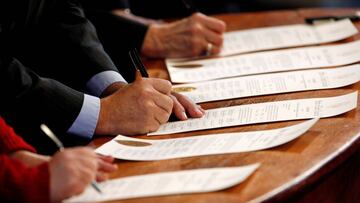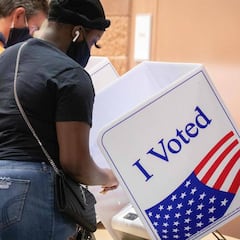USA Election 2020: when do the electors meet?
After you cast your vote on 3 November the process isn’t over. Your members of the Electoral College meet in state and vote for the next president.

Who are electors?
The Electoral College was created in 1787 as a compromise between members of Congress choosing a president and qualified citizens voting. According to the Brennan Center for Justice in part because the Founding Fathers were uncomfortable with giving power to the people.
The Electoral College has 538 members, also called electors To be elected president, the candidate must win at least half plus one; or 270 electoral votes.
Each state has the same number of electors as it has representatives in Congress (the House and the Senate combined). Every state has two votes for its Senators plus a number of votes equal to the number of its Congressional districts.
Following an election, the electors vote for the presidential candidate; guided by the winning popular vote across their state. This year the electors' vote will take place on 14 December. When you vote in a general election you are in fact voting for your candidate’s electors.
To help visualize post-election counting, I turned @NASSorg 's resource on canvassing into a graphic. For more details, check out https://t.co/lSG3yU1tYT pic.twitter.com/foKa5DUBIL
— Charles Stewart III (@cstewartiii) August 25, 2020
What happens when electors meet on 14 December 2020?
"The electors of President and Vice President of each State shall meet and give their votes on the first Monday after the second Wednesday in December next following their appointment at such place in each State as the legislature of such State shall direct" United States Code: Title 3, section 7.
As the law above states, after Election Day, on the first Monday after the second Wednesday in December, these electors (voted for by the residents of their respective states) assemble in their state capitals, cast their ballots and officially select the next President of the United States.
BREAKING: The Supreme Court has unanimously ruled that state “faithless elector” laws — which allow states to remove or fine Electoral College delegates who don't vote for the presidential candidate they were pledged to support — are constitutional.
— NPR (@NPR) July 6, 2020
The electors can legally vote for someone other than who the citizens of their state elected. This phenomenon is known as the "unfaithful" or "faithless" elector, but generally this doesn’t happen. In July 2020 the Supreme Court ruled it was constitutional that "faithless" electors could be removed or fined, to avoid chaos following an election.
The candidate who receives the most votes in a state at the general election will be the candidate for whom the electors later cast their votes. The candidate who wins in a state is awarded all of that state’s Electoral College votes. Maine and Nebraska are exceptions to this winner-take-all rule.
The votes of the electors are then sent to Congress where the President of the Senate opens the certificates and counts the votes. This takes place on January 6, unless that date falls on a Sunday.
How does the 14 December vote work?
According to the Congressional Research Service the electors vote by paper ballot, casting one ballot for President and one for Vice President. The electors count the results and then sign six certificates, each of which contains two lists, one including votes for the President, the other votes for the Vice President. These are known as Certificates of the Vote, which the electors sign.
Related stories
The six certificates are then mailed to these officials; one certificate to the President of the U.S. Senate (the Vice President) this is the copy that is officially counted later; two certificates to the secretary of state of the state or equivalent state officer of the jurisdiction in which the electors met; two certificates to the Archivist; and one certificate to the judge of the US district court of the district in which the electors met.
How is the electoral college shaping up this election?


